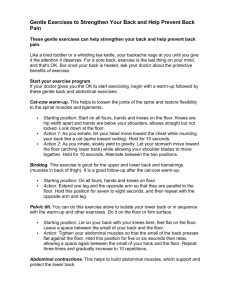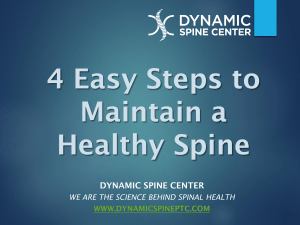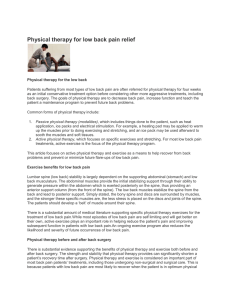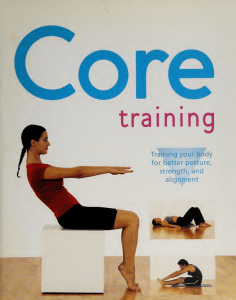General Recommendations for Maintaining a Healthy Back: Patient
advertisement
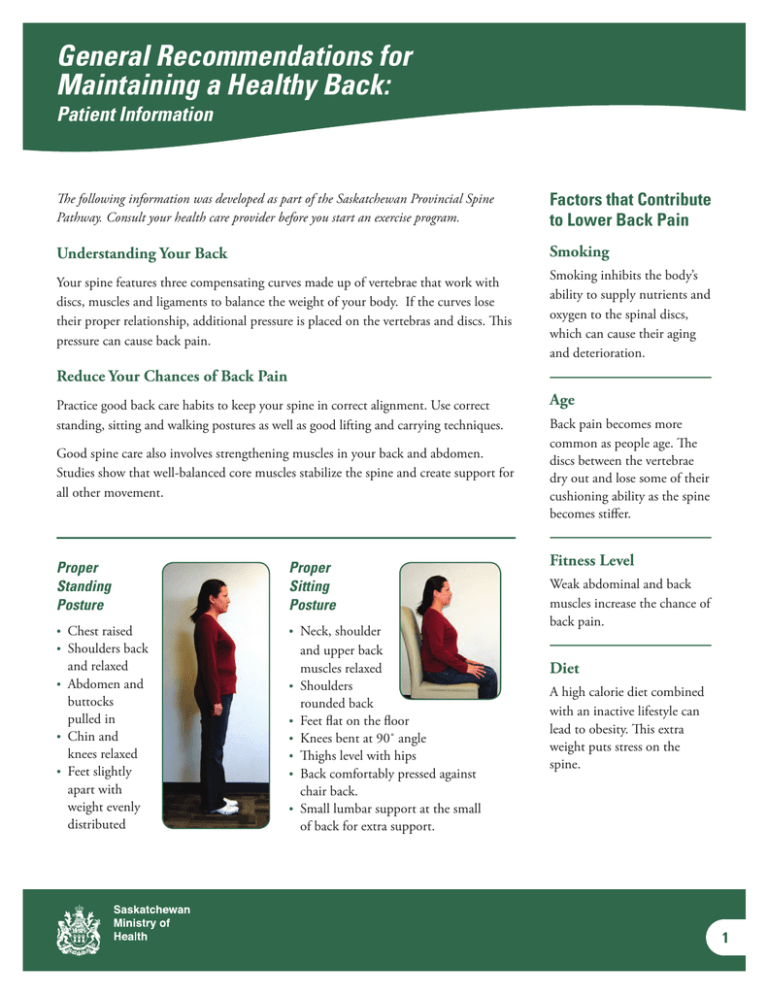
General Recommendations for Maintaining a Healthy Back: Patient Information The following information was developed as part of the Saskatchewan Provincial Spine Pathway. Consult your health care provider before you start an exercise program. Factors that Contribute to Lower Back Pain Understanding Your Back Smoking Your spine features three compensating curves made up of vertebrae that work with discs, muscles and ligaments to balance the weight of your body. If the curves lose their proper relationship, additional pressure is placed on the vertebras and discs. This pressure can cause back pain. Smoking inhibits the body’s ability to supply nutrients and oxygen to the spinal discs, which can cause their aging and deterioration. Reduce Your Chances of Back Pain Practice good back care habits to keep your spine in correct alignment. Use correct standing, sitting and walking postures as well as good lifting and carrying techniques. Good spine care also involves strengthening muscles in your back and abdomen. Studies show that well-balanced core muscles stabilize the spine and create support for all other movement. Proper Standing Posture Proper Sitting Posture • Chest raised • Shoulders back • Neck, shoulder and relaxed • Abdomen and buttocks pulled in • Chin and knees relaxed • Feet slightly apart with weight evenly distributed and upper back muscles relaxed • Shoulders rounded back • Feet flat on the floor • Knees bent at 90˚ angle • Thighs level with hips • Back comfortably pressed against chair back. • Small lumbar support at the small of back for extra support. Age Back pain becomes more common as people age. The discs between the vertebrae dry out and lose some of their cushioning ability as the spine becomes stiffer. Fitness Level Weak abdominal and back muscles increase the chance of back pain. Diet A high calorie diet combined with an inactive lifestyle can lead to obesity. This extra weight puts stress on the spine. 1 General Recommendations for Maintaining a Healthy Back: Patient Information Exercises to Increase Muscle Strength Exercises may be modified at first. Your goal is to keep moving and gradually return to full activity. ❑ Partial Sit-up or Crunch: strengthens abdominal muscles • Lie on back with knees bent, feet flat on floor and arms crossed over chest. • Raise head and shoulders slightly until shoulder blades are just off floor. (You may not be able to get far at first.) Hold for ___ seconds. Relax to the floor. Do ___repetitions. ❑ Reverse Crunch: • Lie on back with hands at sides and knees bent. • Raise feet off floor with ankles crossed so knees create a 90˚ angle. • Tighten abdominal muscles, lift tail bone off floor. • Raise hips towards rib cage. (You may need to use hands for stabilization at first, but rely on them less as you get stronger.) Hold for ___ seconds. Relax to the floor. Do ___repetitions. ❑ Pelvic Lift: strengthens buttocks and abdomen. • Lie on back with knees bent, feet flat on floor and arms at sides. • Raise hips upwards without arching back. • Keep body in a straight line from shoulders to knees. Hold for ___ seconds. Do____ repetitions. Before starting an exercise program, talk to your therapist or primary care clinician. 2 General Recommendations for Maintaining a Healthy Back: Patient Information Exercises to Increase Muscle Strength ❑ Arm and Leg Reach: strengthens buttocks, abdomen and shoulders • Kneel on hands and knees with neck parallel to floor. • Keep weight evenly distributed, knees hip-width apart and back straight. • Stretch one arm straight. Hold for ___ seconds. Return arm to start. Do ___ repetitions. Switch arms and repeat. • Next, lift one leg straight. Hold for _____seconds. Return leg to start. Do ____repetitions. Switch legs and repeat. • As you get stronger, raise opposite arm and leg at the same time. Hold for ____seconds. ❑ Bicycle: strengthens buttocks, abdomen and shoulders • Lie flat on back. Place fingers on head. • Tighten abdominal muscles and bring knees to a 45˚ angle. • Lift shoulders off the ground. Turn upper body to the left, bringing the right elbow toward the left knee and extending right leg in a cycling motion. • Switch sides and repeat. Do ___ repetitions. Switch to the other arm and repeat. Before starting an exercise program, talk to your therapist or primary care clinician. 3 General Recommendations for Maintaining a Healthy Back: Patient Information Exercises to Increase Muscle Strength ❑ Exercise Ball Crunch: strengthens abdominal muscles, improves balance • Sit on ball with feet flat on the floor, about hip-width apart. • Let ball roll back slowly until thighs and hips are parallel to the floor. • Place fingers on head. Keeping lower body motionless, contract abdominal muscles. • Slowly flex forward and lift shoulders off the ball. Do ___ repetitions. Comments Before starting an exercise program, talk to your therapist or primary care clinician. Material was developed by the Saskatchewan Spine Pathway Working Group and should not be republished without the permission of the Saskatchewan Ministry of Health. April 2010 4


